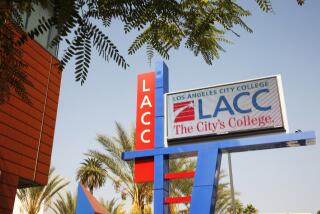For Tiny Whittier College, Big Recruitment Response Is Beautiful
- Share via
WHITTIER — Seventeen years old, sociable, confident, well-traveled and possessing an academic prowess unrivaled by 97% of her high school class, Genevieve Haines was courted by some of the nation’s most prestigious colleges and universities.
Princeton recruiters promised her personal attention from her professors. Harvard brochures boasted of the university’s No. 1 ranking in U.S. News and World Report and its pre-professional programs. Stanford promised diversity.
Yet, on a crystal-clear fall morning, the Issaquah, Wash., native found herself sitting on a folding chair in Whittier, hoping to win a scholarship to attend Whittier College, a college she once knew only as “Nixon’s school,” the alma mater of former President Richard M. Nixon.
Haines is one of nearly 400 high school seniors from across the country who have deluged the Whittier campus with applications to attend the school next year.
Freshmen applications have surged almost 800% at the private, four-year liberal arts school, which in recent years had difficulty recruiting students despite a nationally recognized academic program.
The flood of applications, three months before the deadline, has been attributed to an aggressive marketing campaign launched by President James L. Ash Jr., who has set out to prove that his campus on the hill has more to its credit than just being Nixon’s alma mater.
With personal letters and bold, colorful brochures touting the college’s nationally acclaimed academic program, its small size and its Quaker traditions, Ash and his staff have set out to win the minds of some of the nation’s brightest students.
It didn’t take long for Haines to be persuaded.
“They care about the individual,” she said. “It’s like a small family in a big city.”
The application surge creates a new set of problems for administrators at the 1,000-student college--whom to let in. Administrators plan to admit about 350 freshmen next fall, 80 more than last year. Haines was one of those chosen, winning one of the college’s $55,000 four-year scholarships.
The dramatic increase in applications at Whittier contradicts trends at many of the country’s colleges and universities, which are finding it harder to keep enrollment up, experts said.
Robin Zuniga, a research associate with the Denver-based Western Interstate Commission on Higher Education, said demographic studies done by the commission show that fewer students are graduating from the nation’s high schools.
From 1988 to 1992, Zuniga said, the number of students graduating from public and private high schools is expected to drop by about 12%. Though some of the decline can be attributed to such factors as dropout rates and population mobility, most of the decrease is caused because fewer children were born between 1970 and 1974, she said.
Whittier College’s experience so far this year is unusual, Zuniga said.
“From what I’ve seen so far, and what I’ve read, most institutions will experience a decline,” she said.
Whittier school officials, though elated by the application rate, are cautious.
“You really don’t know what enrollment is going to be until you count heads on the first day of class,” said Kathryn Forte, vice president for enrollment and student life. “But we can see that we are just having some extraordinary results. Last year at this time we had 45 freshman applications. This year we now have 396. . . . It’s mind-boggling.”
Forte said a third of the applicants promised to withdraw other college applications if they are accepted to Whittier. The deadline to apply at Whittier College is in February. Forte said that traditionally, the college receives most of its applications in January and February but that there is no way to tell if the students applying now are those who usually would have applied later. She also said that experience has shown that about 40% of those students who are admitted will actually enroll.
Forte, once the director of admissions for USC, said she attributes the increase to several factors:
--A recruiting drive that sent Ash and other Whittier administrators to more than 600 schools in 25 states from Massachusetts to New Mexico, Arizona and Washington.
--A more sophisticated mailing system and more polished brochures. One of the first brochures prospective students receive from Whittier College is a small yellow notebook that has nothing but a picture of the white doors of admissions hall and the words “Enter Here” on the cover. The doors appear to be slightly ajar, and in fact, can be opened to reveal a bright blue sky and the gleaming white paint and red tile roof of a classroom building. Inside the notebook, thick, glossy pages tell of the school’s spirit, sense of community, values and the unique academic program that is the heart of its curriculum. Prospective students are encouraged to “take a closer look” by spending some time on campus.
--The planned expenditure of $18 million on campus renovations, including the completion of the Shannon Center for the Performing Arts, the modernization of residence halls, and the construction of the faculty masters housing, in which three faculty members and their families live on campus next to the student dormitories. The construction is nearly complete.
There is one last thing to which Forte attributes the unprecedented popularity of the college: Ash. “He’s been described as our secret weapon,” Forte said.
Ash has not stopped moving since he was first hired last year, students and staff said.
“There have been a lot of changes, real fast,” said Amy L. Szczukowski, editor-in-chief of the Whittier College paper, the Quaker Campus. “All in all, it’s been positive.”
Ash made it clear early in his tenure that student recruitment would be one of his top priorities. His strategies have provoked some controversy. He budgeted millions on landscaping and dorm renovations, convinced that no one chooses a college anymore without looking first. The action was criticized by students who felt he should be spending the money on books. He has spent hours on the road, wooing not only students such as Kathy Zuckweiler, a Colorado Springs senior who is ranked at the top of her class, but their parents.
“We were very impressed with Ash,” said Zuckweiler’s mother, Janet. “He was a strong factor in the decision to apply here.”
Ash was hired earlier this year from the University of Miami, where he received most major teaching awards offered by the university and played a leading role in boosting enrollment and strengthening undergraduate studies.
His plans to do the same for Whittier College seem to be working, though Ash is reluctant to declare that his strategies have paid off.
“These are certainly good signs, but one can never be sure what the enrollment patterns will be until the students actually come to campus and go to class,” he said.
Still, Ash said, “it was an ambitious plan, some would call it audacious, but it appears to have worked.”
The stakes are high.
Whittier College receives almost two-thirds of its revenue from tuition, which runs around $13,000 a year. Though the college is not suffering from the financial burdens of the past, it is far from wealthy. Its endowment fund is a meager $17 million. Pomona College, an institution of similar size, has an endowment of $271 million.
Despite the tantalizing thought that hundreds of students bearing thousands of dollars could end up at Whittier College, Ash is adamantly opposed to admitting as many qualified students as possible just to bring more money into the school.
“Many universities would take this good fortune and accept every qualified student,” Ash said. “We will not do that. We don’t want to make educational compromises.”
Such compromises might be allowing a teacher’s aide to teach a class, or increase the professor-pupil ratio, neither actions upon which Ash looks favorably.
More to Read
Sign up for Essential California
The most important California stories and recommendations in your inbox every morning.
You may occasionally receive promotional content from the Los Angeles Times.













